San Antonio Express News
Gardening, ETC.
Sunday, February 26, 2006
WINTER DROUGHT-STRESS ON SAN ANTONIO LANDSCAPE
by
David Rodriguez
Normally most of us would not be talking about watering problems
in our landscapes until about July or August when the temps are
100 degrees plus. Are we in winter, spring or in a drought? The
way the temperatures have been changing in San Antonio, you would
have better luck picking the winning lottery numbers. It has been
so uniquely ever-changing. Many plants are now leafing out. Regardless
of the temperature extremes this winter, one obvious thing can
be said. We have not had a significant, cold-damaging winter thus
far, but we have had very thirsty landscapes.
The average rainfall for the last 30 years has been approximately
33 inches a year. San Antonio rainfall last year was less than
17 inches. First grade math taught me that 33-17=16. Thus stating,
we were 16 inches below normal rainfall last year. And per monthly
statistics, we are already 2 ½ inches behind for 2006.
That is a lot of rain to be lacking.
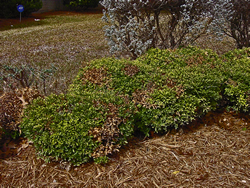
Pittosporum hedges showing drought's characteristic dead
sections |
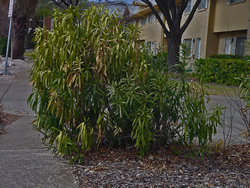
Oleander shows drought damage of dull green foliage and
dead limbs on top and left side of plant |
Simply drive around town and exam shrubs and trees. Evergreens
are showing drought damage including Yaupon hollies, Burford hollies,
Ligustrums and live oaks, just to name a few. Around town, even
Southern Magnolias can be seen dying or are already dead. Many
of these older and well established plants did not have supplemental
irrigation throughout this winter. They are showing enormous and
severe amounts of drought stress in the visual symptoms of wilting,
dull green leaves, smaller leaves, sparse foliage and blooms,
brown branches in hardy shrubs and shriveled wood. The lack of
normal rainfall that usually occurs in the fall might have had
an impact on these visual symptoms in present landscapes. Hopefully
this coming summer, we will not see even more of these lagging
drought problems.

Dead Magnolia in the center flanked by severely drought-damaged
Magnolia on the right and a just-beginning-to-show-drought-symptoms
Magnolia on the left |
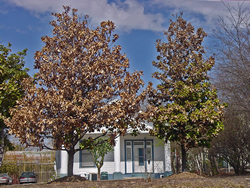
Dead Magnolia on left with dieing Magnolia on the right |
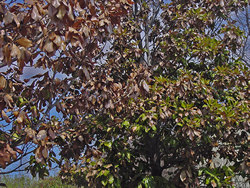
Completely dead Magnolia foliage on the left compared to
leaves which are half-dead on the Magnolia tree on the right |
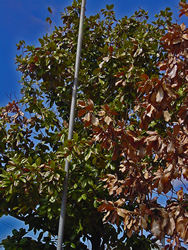
Completely dead Magnolia leaves on the right means the tree
is dead. Dead branches on the Magnolia tree on the left
means the tree is beginning to die |
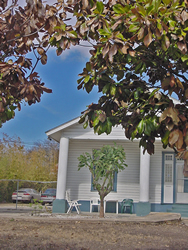
A healthy cactus browning bamboo and completely dead grass
with dead and dying Magnolia leaves framing the image is
a portrait of drought damage. |
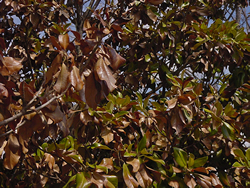
Completely dried brown leaves on the left indicate the Magnolia
tree is dead. Partially browned leaves on the right are
on a tree being killed by drough. |
When walking outside in your lawn, ask these questions: 1) When
was the last time you properly watered? 2) Is the grass brown
and crispy due to a lack of supplemental irrigation or rainfall?
If your lawn is suffering, most likely it is from lack of moisture.
We cannot use the excuse that our lawns are still dormant. Why
are some people's lawns (St Augustine lawns) still pretty and
green? Ask them! They have been watering throughout the winter!
How can we prevent drought stress damage, not only now, but everyday
throughout the year and maintain beautiful, efficient landscapes?
The answer is simple...water. Utilize compost, mulch and water
again! And select the best adapted variety of plant for the ideal
location.
 Magnolia showing the beginnings of drought
damage on the left with a dead Magnolia on the right. The
little bit of mulch around the base of the tree is
Magnolia showing the beginnings of drought
damage on the left with a dead Magnolia on the right. The
little bit of mulch around the base of the tree is |
If you have not received at least one inch of rainfall in your
landscape in the last month, you need to water your landscape
NOW. This water will be critical for the growth and survival of
your established plants. Watering is even more critical prior
to a really hard freeze, because freezing is a desiccating process,
which pulls water out of the cells. Another point to remember
in watering your landscape is to remember the trees and shrubs.
Most yards are equipped with sprinkler systems, but in most cases
this does not help the shrubs because often the systems are installed
only to accommodate the lawn area. YOU NEED TO COMPOST YOUR LAWN
at least twice a year. This is an important key in water conservation
and reducing your water bill. Aerate your lawn in January with
a core aerator and top dress with compost in February and mid-October.
Please! Your grass will thank you and so will your pocket book.
Apply a minimum of a 1-inch layer of compost (top dressing) by
simply feathering it evenly across the lawn. This is the key to
reducing water needs and even fertilizer in your lawn. Consider
reducing the size of your lawn area by adding colorful beds of
water saving plants.
Use a soaker hose on established shrubs with enough pressure
to squirt water at least 3 inches high from all openings of that
hose. The soaker hose should be inverted in the area between the
foundation of the house and the base of the shrubs. Four inches
of a good grade landscape mulch (i.e. cedar or hardwood) should
be applied on top of the hose and around the shrubs at least once
a year. This system should be operated at least four hours a day
every two weeks in lieu of an inch of rainfall. Keep away from
soaker hoses that sweat, because they normally clog up and are
much harder to regulate watering patterns. This watering technique
should help to keep your residence foundation from cracking.
In times of very severe drought-stress, it may be necessary to
apply additional water by using the same system at the drip line
of trees, shrubs and grass-one inch of water per week. Soil holds
enough water for two to three weeks, so you need to water at least
every three weeks during the growing season unless rain is received.
This will allow the water to saturate the soil to at least a foot
to 18 inches. So apply water less often, but for longer periods
of time, at a slow rate. The most ideal system would be to apply
the amount of water that the plant needs every day, but when you
attempt to do this, your plants will become totally dependent
on you. Should you stop, the plants will die.
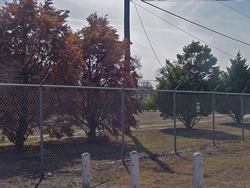
Drought-damaged Leyland Cypress on left with suffering-but-not-dead
plants on right |
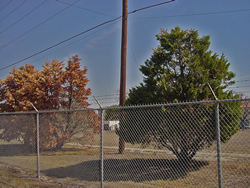
Completely drought-killer Leyland Cypress on left next to
a plant which is just beginning to exhibit symptoms of branch
dieback on right |
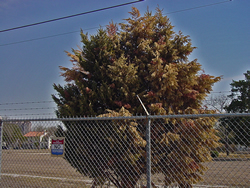
Recently drought-damaged Leyland Cypress |
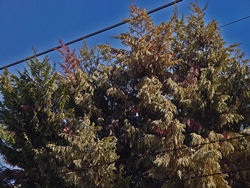
Severe branch dieback of drought-damaged Leyland Cypress |
For more information on winter watering during a drought visit
http://www.plantanswers.com/drought_watering.htm
There is a new Landscape Maintenance Guide published by SAWS
that is selling at area nurseries for about $8. This is a full
color guide that proves that landscape beauty in San Antonio is
a reality, twelve months of the year.
Many of our nurseries are already stocked with a beautiful array
of spring color. You can plant containerized plants almost any
time of the year, even if we do not get any supplemental rain.
Remember to select the most adapted species of plant (not necessarily
native) to fit in the landscape. Water well for initial establishment.
Use liberal amounts of compost at planting time, and top dress
your lawn twice a year. Mulch trees and flower beds at least once
a year.
Special Note: This article was written last weekend, meaning
that we probably received a little taste of rain during this week.
This article presents sound drought prevention practices that
will not only save water, but also keep our landscapes in livable
conditions. This week's rainfall was only a small drop in the
bucket.
==============================================
==============================================
DYING OF THIRST
by
Tracy Hobson Lehmann
Express-News Home & Garden Editor
Winter really didn't happen this year, save for a couple of shivering
spells, and Mother Nature turned off the tap on rain more than
a year ago.
"Just driving around town in the last few weeks, we've started
seeing a large array of evergreen plant material that looks stressed,"
notes David Rodriguez, horticultural agent with the Texas Cooperative
Extension office in Bexar County. "What people normally think
is winter damage is drought damage. We haven't had a significant
winter."
Live oaks are dropping leaves earlier than normal, and usually
vibrant primrose jasmine plants are looking as if they were nipped
by frost, showing brown leaves and few flowers. Even landscape
standards such as yaupon and Burford hollies are showing stress.
"When you start having dead leaves in established burford
holly and yaupon holly, there's only one thing that will do that:
drought," says Jerry M. Parsons, Texas Cooperative Extension
horticulturist and co-host of a weekly garden radio show.
WEATHER DATA
When it rains
Average rainfall: 29.08 inches *
Normal: 32.92 inches **
============================
High and dry
2005: 16.56 inches
1917: 10.11 inches +
1956: 14.31 inches
Soaked
2004: 45.33 inches
1973: 52.28 inches +
1957: 48.83 inches *Average annual rainfall calculated from 1871-2005
**30-year average from 1971-2000
+Record years
==========================================
Responding to plants' SOS
Signs of distress
* Dull green leaves.
* Wilting.
* Smaller leaves.
* Sparse foliage and blooms.
* Brown branches in hardy shrubs.
* Shriveled wood.
==========================================
Steps to take
* Water deeply rather than giving frequent shallow irrigation.
Do not overwater.
* Use soaker hoses around foundation plantings. Lay hoses between
the base of the shrubs and the foundation. Allow to run about
3 hours initially.
* Mulch around shrubs after watering. Mulch helps retain moisture
but serves no benefit on dry ground.
* Aerate lawns and apply compost top-dressing.
==============================================
Not only has the area gone without significant rainfall since
December 2004, forecasts through May don't look promising for
precipitation, according to Clay Anderson, senior forecaster with
the Austin/San Antonio forecast office of the National Weather
Service. Rainfall for the year is 2.06 inches below normal and
down 3.92 inches since Dec. 1.
To add to the problem, plants went into the drought spoiled by
a very wet 2004.
The impact has hit hard at the San Antonio Botanical Garden,
with a 28-year-old magnolia and some maples and sweetgums falling
victim to the dry weather. The biggest impact, though, will be
on wildflowers, says Paul Cox, assistant superintendent at the
garden.
"It's going to be a pretty dismal wildflower display,"
he says. "I walked areas and looked, and what bluebonnets
I could find were less than the size of a quarter. They should
be 6 inches across, easily."
Lawns, too, are feeling the effects of the dry weather. St. Augustine
grass that remains brown now isn't dormant, it's thirsty, says
Parsons. Give it a drink and it will spring back, but it might
be thin. Letting turfgrass go too long without adequate water
will cause it to be so sparse that the lawn will have to be resodded.
Karen Guz, conservation director at San Antonio Water System,
says turf needs an inch of water a month under current conditions.
SAWS and Bexar County Master Gardeners provide homeowners with
lawn-watering recommendations on SAWS' Web site, and the guidelines
are published Saturdays in S.A. Life. The Seasonal Irrigation
Program recommendations are derived by a formula that measures
temperature, humidity, wind and solar radiation.
In the past, SAWS has not maintained the SIP program during winter
because landscapes seldom require supplemental water. However,
the utility says it will begin sending out weekly e-mail reminders
to customers who have signed up for the free service, and it has
posted watering recommendations on the Web at www.saws.org.
While it would be optimal to apply the water all at once for
a thorough soaking that would encourage deep roots, Guz says homeowners
with shallow soils would do better applying a half-inch of water
every two weeks in the absence of rain.
Guz encourages homeowners to evaluate the soil that's supporting
their grass. If the soil is less than 4 inches deep, consider
applying compost topdressing, which will work its way under the
roots and build the soil. Deeper soil allows for deeper roots,
which are better able to hold moisture. Deep watering also encourages
roots to reach deeper into the soil.
SAWS imposes year-round restrictions on landscape watering times,
limiting sprinkler irrigation to the hours of 8 p.m. to 10 a.m.
Though the aquifer level remains well above the 650-foot level
that would require additional limitations, the restrictions are
looming if there is no replenishing rain. "The earliest we're
projecting is as early as April," Guz says. "We don't
really think that. It's just our worst-case scenario in the modeling.
It's more likely in later summer, even late July."
The aquifer last dipped below the 650-foot trigger level in 2002.
Restrictions were in place for only one day before downpours caused
flooding. Homeowners last experienced extended water restrictions
in 2000.
Guz looks at plant performance during droughts in 1996 and 2000,
noting that native and adapted plants fared OK. Non-native plants
- she cites magnolias - might not do so well.
This is a good time, Guz says, to look at reducing the amount
of grass in landscapes to minimize water use. SAWS offers rebates
to qualifying customers whose landscapes have less than 50 percent
turf.
"If people have been thinking about getting rid of grass
areas, it's a good time to do that," she says. Remove the
turf and mulch the new beds, then plant in fall when - with luck
- we'll have rain.
==============================================
==============================================
Roddy Stinson article: 'You get penalized if you try to keep your
trees alive and green' on Feb. 21, 2006 San Antonio Express-News
=================================
"Roddy, I don't understand the people at City Hall,"
said a "confused" San Antonio woman who left a message
on my phone over the weekend.
"They don't want you to cut down any trees, but they penalize
you if you try to keep your trees alive and green and healthy.
"For the life of me, I can't figure it out."
Her confusion is understandable.
Mayor Phil Hardberger and the City Council spend considerable
time, energy and tax dollars defending North Bexar County trees
from the bulldozers and chainsaws of landowners/developers.
Meanwhile, they and the San Antonio Water System directors they
appoint penalize homeowners who water their trees during dry spells.
As explained in a recent column, water usage between Nov. 15
and March 15 determines year-round sewer charges; so watering
trees to keep them "alive and green and healthy" in
December, January and February produces higher than normal sewer
bills in June, July and August.
Add to that financial slap the recent annual increases in water
rates and you end up with ...
1. Punishment of would-be tree-savers.
2. Bewildered homeowners who see a contradiction between what
City Hallers say and what City Hallers do.
Being neither a mind reader nor a herpetologist, I can't get
into the heads of city politicos and pull out reasons for their
actions. But in this contradictive case, it's easy to come up
with an educated, two-word explanation:
Hidden agenda.
At City Hall, private philosophies and personal political leanings
determine virtually all actions.
Example in point:
A majority of city officials and the constituencies that elected
them are urban liberals who have a deep, predominant conviction
that most community resources, public and private, should be poured
into the inner city.
To accomplish that inner-city goal, they have to come up with
ways to limit community investment on the fast-developing far
North Side. Of course, they can't publicly state their anti-North
Side bias for fear of opening up cans of political and legal worms
that make their hidden objective harder to reach
What to do?
One possibility:
Make North Side development as difficult and as expensive as
possible by passing and vigorously enforcing rules, regulations
and ordinances that favor flora and fauna over family residencies
and private businesses.
Such tactics are easily defended and give City Hallers the moral
high ground from which they can pontificate with impunity. ("Dear
Lord, save our noble mesquites and loyal scrub oaks. Amen.")
To put the matter more simply:
It's not about the trees.
It's NEVER about the trees.
Or the recharge zone.
Or the contributing zone.
Or "scenic values."
Or spotted skunks.
Those red herrings are only sure signs of a hidden agenda.
As for the matter of watering trees between Nov. 15 and March
15 ...
The mayor and council have expressed little concern for the thirsty
flora in San Antonians' yards. Why such indifference?
Another educated guess:
The politicos would like for the owners of those yards to water
their trees, bushes, grasses and weeds as frequently as possible
since City Hall receives 2.7 cents of every windfall dollar that
the flora's owners send to SAWS
To put the matter more simply:
It's about the cash.
It's ALWAYS about the cash.
Or the dough.
Or the bread.
Or the oil of palms.
And its redistribution.
Forever and ever.
Selah.
|



